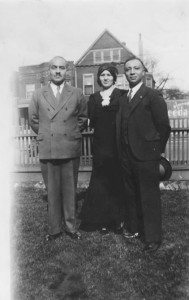GLENVIEW, Ill. (A.W.)—On the occasion of the Armenian Revolutionary Federation’s (ARF) 123rd anniversary, the film “Garegin Njdeh” was shown on Saturday evening, Nov. 23, in Glenview at the Armenian Community Center’s Shahnasarian Hall, followed by a reception. The Chicago “Christapor” Chapter of the ARF and the Chicago chapter of the Hamazkayin Armenian Educational and Cultural Society sponsored the event.

The film, with English subtitles and an array of outstanding actors and actresses, delved not only into the life of a great national hero but also into a nation’s struggle for self-determination. Filmed in Armenia, Russia, Poland, and France, the poignant and beautifully produced motion picture was written by Krist Manaryan and produced and directed by Hrach Keshishyan. The cinematographer was Mkrtich Malkhasyan.
The name Garegin Njdeh had been introduced to the Armenian community of Chicago before, not in a film or in the song “Garegin Njdehi Yerku,” but during a lecture he had given in the fall of 1933 at a meeting of the Chicago chapter of the Armenian Relief Society (ARS). The lecture was titled, “The Woman’s Role and Obligation.” The following are a few quotes from Njdeh’s lecture:
“A people is nothing but the spiritual expression of woman… A people, in whose life the woman has no role, has no future… It is indispensable that the Armenian remain Armenian outside of Armenia. Within and outside of Armenia, the woman’s role must be to spread and inspire the concept of Fatherland… The Armenian mother is the one who must instill belief, strength, and pride in the soul of the race… The nation that looks down is not a nation. The one that looks up sees ahead… As long as the world pities us, we shall remain slaves…”
The late Hovagim Hovagimian (the son of Archpriest Karekin Hovagimian, the Chicagoland and Wisconsin Armenian communities’ first priest, serving during the 1920’s to 1930’s), a long-time correspondent and contributor to the Armenian-language newspaper Hairenik and an active member of the ARF’s Chicago chapter, wrote of the momentous event, which was published in the Hairenik on Nov. 18, 1933.
Hovagimian’s meeting with Njdeh in Chicago had not been his first. They had initially met in Yerevan at the end of 1915, when Hovagimian was serving in the Reserve Regiment in Nork and in the Fifth Brigade led by Vartan, the hero of Khanasor. In his memoirs, Hovagimian had written of Njdeh, “He wore a Bulgarian officer’s uniform and conducted the drills of the Armenian volunteers in Nork… He was accessible to everyone, modest and sociable… He hated pretense… He had a cultured and thoughtful mind, and he was a great and inspiring orator. He was the model of an indefatigable, selfless, and patriotic soldier of the Armenian World…”
During Njdeh’s visit to Chicago, he stayed at the home of Mr. and Mrs. Hovagim and Vergine Hovagimian. Years later, upon hearing of Njdeh’s death, Hovagimian had written, “ Caught up with sad memories, we (he and his family) often glance up at a pair of Italian flower pots, which were given to us by Unger Njdeh, and see them as mementoes full of Armenian spirit… Incense and Blessing be his immortal memory.”
General Garegin Njdeh Ter Harutyunyan, the great revolutionary and national hero, political activist, military leader, and founder of the Armenian youth group called the Tseghagron—renamed the Armenian Youth Federation (AYF) in 1933—offered the ultimate gift to his beloved Armenian nation: his life. Often just called Njdeh, which means “pilgrim” in Armenian, his life was a journey of exalted purpose.
The youngest of four children, he was born in the village of Kznut in Nakhichevan, Armenia, in the winter of 1886. He was the son of a priest, Ter (Father) Yeghishe, who it is believed was poisoned at a wedding. His widowed mother, Yeretsgeen (wife of a priest) Dirouhi, raised their four children.
Witnessing the oppression and aggression that befell his people again and again, and their defense of life, home, and land, at the age of 17 Njdeh joined the Armenian liberation movement. He studied law in St. Petersburg, Russia, and continued his education at the military college in Bulgaria. In 1948, Njdeh was taken into custody as a political prisoner by the Soviet government and sentenced to serve 25 years in prison. He died in Vladimir prison in Vladimir, Russia, in the winter of 1955 and was buried in the prison yard.
In the summer of 1983, his family secretly arranged to have his remains moved to Armenia, where he was laid to rest at Spitakavor Church, near Yeghegnadzor, located near the foot of the Zangezur mountain range—his beloved mountains—with some of his remains buried on the slopes of Mt. Khustup near Kapan.
Garegin Njdeh—“Incense and Blessing be his immortal memory.”


Thank you Knarik for this interesting reflection and personal angle on Garegin Nzhdeh’s life. The Spitakavor church, where he is buried, is located in the valley dominated by the Proshabert fortress which can be seen from our house in Yeghegnadzor. We often organize pilgrimages on foot to visit Spitakavor through scenic mountain gorges, crystal clear springs and hospitable shepherd villages with their delicious mountain honey and matsoun.
Worth a visit when you come back again (haven’t seen you since our volunteer year). Best wishes for the Season.
It would be great if we could see Njdeh’s quotes in Armenian. I can’t find them anywhere.